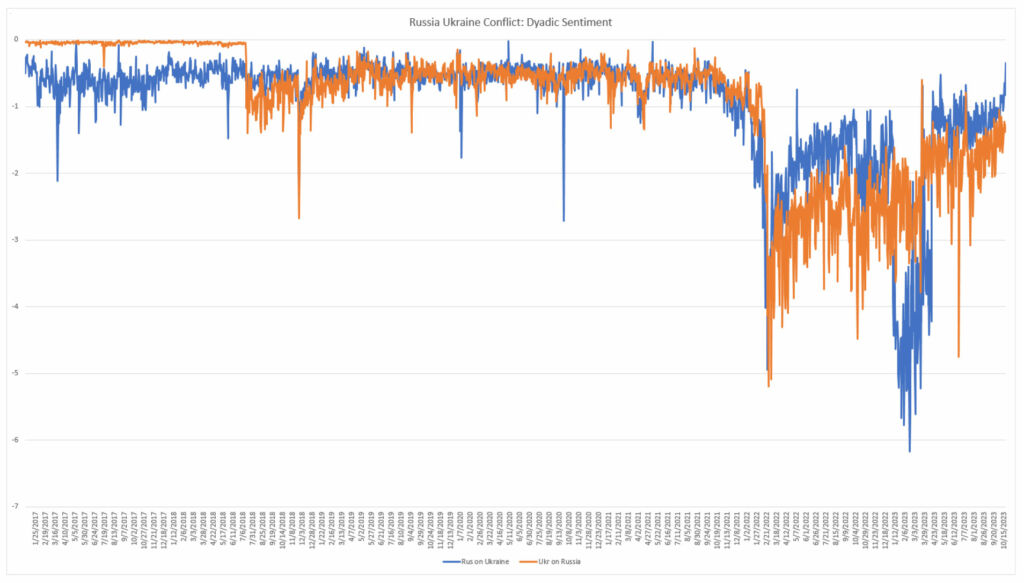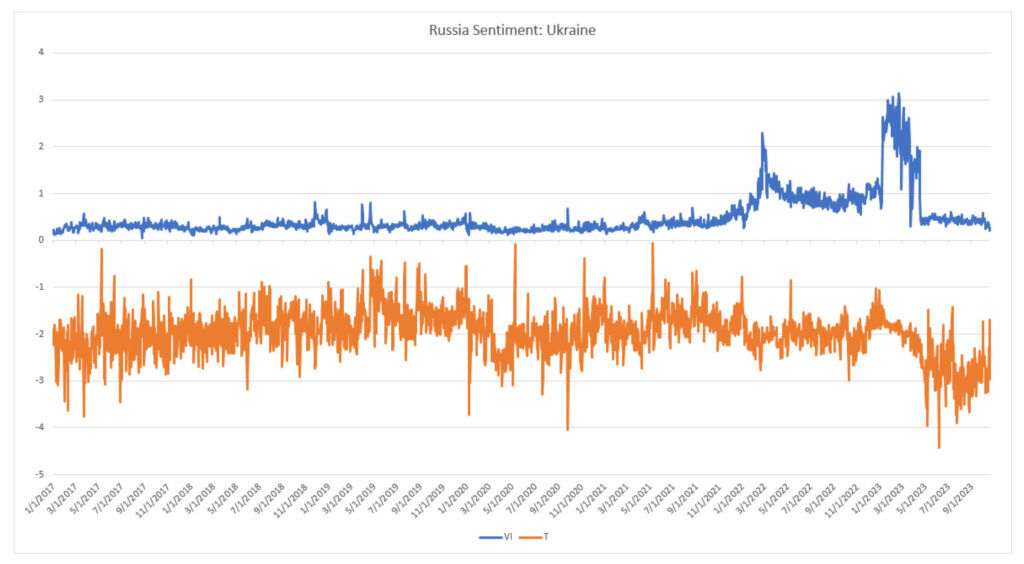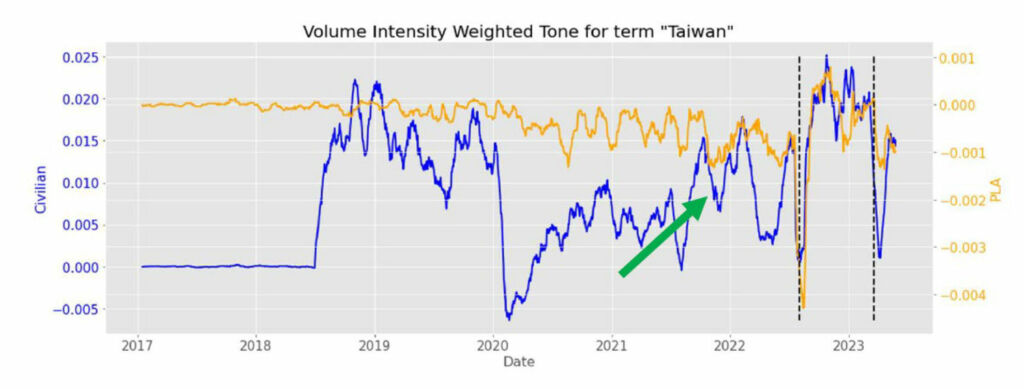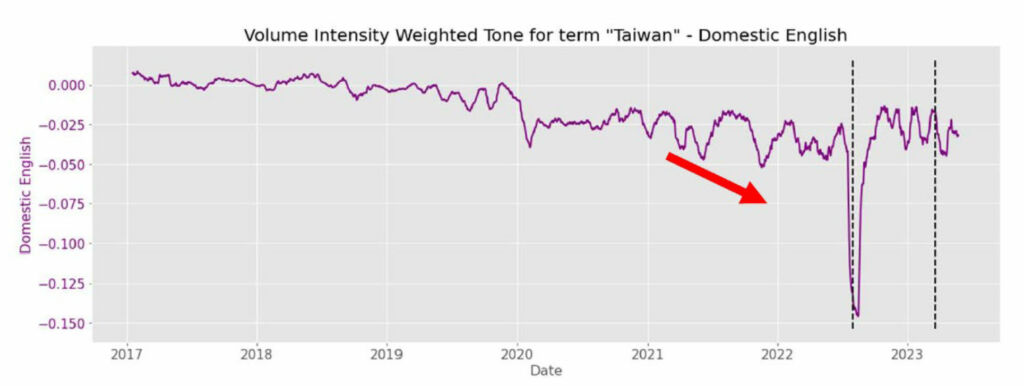By James R. Sullivan, CFA
Abstract:
The stories that a country tells itself and others help us to understand how that country sees itself, its place in the world, and its ambitions. Sentiment analysis applied to these stories also provides evidence that countries prepare the narrative ground in advance of military action in similar ways as they prepare the physical battleground. This dynamic was especially apparent prior to the 2022 Russian invasion of Ukraine. This paper provides updated sentiment analysis for one ongoing and one potential conflict.
Russian sentiment towards Ukraine, as expressed in domestic language media, fell precipitously in the days preceding the 2022 invasion of Ukraine but has now repaired to levels not seen since pre-invasion. Alternative takeaways for this phenomenon are explored, inclusive of potential posturing in advance of negotiations, but also potential preparation for a sustained lower-intensity conflict.
China’s sentiment towards Taiwan, as expressed in domestic language media, has been positive for some time. One potential conclusion is that the dehumanizing rhetoric that Russia used to prepare the narrative battleground in Ukraine is missing from the China / Taiwan situation.
Politics by Numbers: Plato’s Shadows Provide a Ray of Hope?
Plato argued in his allegory of the cave that people do not directly observe reality but instead see only its shadow, as reflected in the dim firelight thrown upon the walls of the cave. The captives in his cave collectively interpreted these imprecise profiles, granting “prizes to one another for being the best at recognizing the various shadows.” This social interpretation of a meta-reality was an interesting foreshadowing of, by more than 2,370 years, the ideas inherent in a Constructivist view of international relations as first posited by Wendt in 1992 as he argued that a state’s behavior is not only based on Morgenthau’s Realist school views regarding absolute physical power differentials but is also based on the state’s perceptions of others. This socially constructed reality was next applied to a state’s perception of itself by Mitzen and others in an effort to describe the evolution of Herz’s Security Dilemma, where one actor’s physical security creates insecurity for another; to Jervis’s Perceptual Security Dilemma where misperceptions of state intentions can lead to escalatory spirals; to Mitzen’s aforementioned Ontological Security Dilemma, wherein one state’s definition of who it is creates identity insecurity for another.
The stories a regime tells its own citizens as well as other parties are therefore critical for several reasons. First, they help to define the state in relation to its goals. Per Weber, “at a minimum, in order to be a great power, a power has to think of itself as being great, of having an historical task.” Second, they define the state in relation to the system; as per Lind, “political contestation is a contest between narratives.” Lastly, they can help provide explicit justifications for action by providing a conceptual framework to justify the course chosen at both a strategic (Miller’s “grand strategies themselves are underpinned by ideas”) and a tactical level.
Methodology
New tools such as Natural Language Processing combined with databases such as the Global Database of Events, Language, and Tone (GDELT) from Google’s Jigsaw Project allow analysis of these stories in greater depth than previously possible. This paper builds on methodology first used here to analyze the stories that a government is telling various internal and external audiences in an attempt to understand the potential for future strategic and tactical actions. The area of enquiry for this paper will focus on exploration of a state’s use of narrative to prepare a body politic for kinetic actions.
Natural Language Processing (NLP) tools are leveraged against the GDELT database to quantify the stories told by a government about certain topics to certain target audiences. Specifically, the total volume of stories (V) published on a particular topic is measured as a percentage of the total volume of stories (TV) published in the target country / language / publication in question (V / TV = Volume Intensity or VI). The tone (T) regarding the topic is calculated within GDELT (technical information regarding sentiment dictionaries used, calculation, and contextual analysis is available here). Multiplying the Volume Intensity (VI) times the tone (T) gives us the Volume Intensity Weighted Tone (VIWT), which proxies the tone adjusted for frequency, which is important to weed out high tone / low volume results.
Case Study 1: Russia / Ukraine
This methodology is deployed to understand changes in sentiment in articles in Russian published in Russia discussing Ukraine and articles in Ukrainian published in Ukraine discussing Russia prior to the 24 February Russian incursion into Ukraine. Analysis of relative sentiment within this dyadic pair is shown in the figure below:
Figure 1: Russia and Ukraine Volume Intensity Weighted Tone towards each other
 Source: GDET Database http://www.gdeltproject.org
Source: GDET Database http://www.gdeltproject.org
There are several items of interest. First, there is a significant deterioration of tone in the Russian press regarding Ukraine in the weeks prior to the physical invasion. Sentiment reached new short-term lows on 4th and 25th December 2021 and 15th January before moving to a lower level (4th February) just prior to the physical incursion (24th February). This sentiment deterioration is not dispositive of anything in isolation but was potentially a sign that the Putin regime was preparing the narrative ground for an attack that could result in significant casualties by dehumanizing the adversary in advance. This data implies a potentially very different signal vs. the chorus of experts at the time insisting that Putin would not invade Ukraine, ranging from Chatham House to the Atlantic Council to Al Jazeera. Russian sentiment deterioration towards Ukraine both pre-dates the invasion as well as leads to sentiment deterioration towards Russia in Ukraine.
Two other datapoints deserve note. First, the low point for Russia’s sentiment towards Ukraine occurred in January / February 2023, coinciding with steep losses sustained during the battle for Bakhmut and the one-year anniversary of the invasion. Second, sentiment in Russia towards Ukraine, as well as sentiment in Ukraine towards Russia, has recently improved significantly, beginning in April 2023, with current Russian sentiment towards Ukraine at levels not seen since pre-invasion.
It is important to a) not over-extrapolate any specific conclusions from this improvement in sentiment and b) understand the specific drivers underlying the shift. The VIWT term can be disaggregated to Volume Intensity (percentage of stories discussing the term of interest) and Tone. In this instance, the dramatic improvement in the Volume Intensity Weighted Tone in Russia towards Ukraine is more a function of a reduction in Volume Intensity (blue line) per the figure below.
Figure 2: Russian Volume Intensity and Tone towards Ukraine
Source: GDET Database http://www.gdeltproject.org
The exact conclusion of this data is unclear. That said, a potential interpretation relative to recent history is that Russia is not currently preparing the narrative ground for any significant increase in hostilities toward Ukraine. An alternate interpretation is that the regime is attempting to turn down the temperature of coverage of hostilities. The potential danger of this conclusion is that by “changing the channel,” the regime may be attempting to create an environment where low-intensity conflict may be sustainable for a longer period.
Case Study 2: China / Taiwan
The same tools are then deployed to better understand similar dyadic narrative differentials between China and Taiwan. The GDELT database allows for further specification to isolate stories published in different language publications, or specific publications, in a target country about a particular topic. This capability allows the construction of proxies for specific target audiences. Mandarin-language stories within Mainland China are more likely targeting a domestic audience, while English-language stories are more likely targeting an international audience. Stories published in the People’s Daily can be used as a proxy for stories targeting a civilian generalist audience, vs. those published in the People’s Liberation Army Daily serving as a proxy for stories targeting a military audience.
The analysis of sentiment trends in the Russia / Ukraine case study would suggest (but not prove) that any significant deterioration in sentiment expressed in China towards Ukraine should be seen as a potential sign that China is preparing narrative ground for future kinetic actions. Thankfully, the evidence in this case is starkly different from that seen in the Russia / Ukraine data. The figure below shows sentiment in stories published in Mandarin (arguably targeting a domestic audience) in China discussing Taiwan. The blue line tracks these stories in the People’s Daily, arguably a proxy for a civilian target audience, while the yellow line tracks the same in the People’s Liberation Army Daily, proxying a military target audience.
Figure 3: China Civilian and PLA Volume Intensity Weighted Tone towards Taiwan – Mandarin Publications
Source: GDET Database http://www.gdeltproject.org
The clearest takeaway is that the VIWT in the People’s Daily (blue line) is consistently positive (LHS) and arguably trending higher. The sentiment drawdowns at the dashed lines represent then-US Speaker of the House Representative Nancy Pelosi’s visit to Taiwan in late 2022, and Taiwanese President Tsai’s visit to the United States in early 2023. In both instances, sentiment clearly recovered quickly and remains at a high level.
The most important conclusion is that there is no evidence of the type of narrative preparation seen prior to the Russian invasion of Ukraine. China’s official media consistently discusses Taiwan and Taiwanese people in positive terms, something that would create difficulties if kinetic activities were planned soon. Again, this analysis is not dispositive but is indicative that China is not preparing the narrative ground for any physical conflict with Taiwan that would create causalities.
The picture changes somewhat if the same analysis is conducted only on English language stories vs. the Mandarin language analysis above. Sentiment expressed in English in China discussing Taiwan is consistently negative per the figure below.
Figure 4: China Volume Intensity Weighted Tone towards Taiwan – English publications
Source: GDET Database http://www.gdeltproject.org
One potential conclusion is that English language narratives are designed more for international signaling to a foreign audience. This is a subject deserving incremental research.
Limited vs. Free Press Regimes
Both case studies presented above center on sentiment as expressed in authoritarian regimes with little press freedom. Indeed, China ranks 179th out of 180 in the World Press Freedom Index (WPFI) developed by Reporters without Borders, and Russia a marginally better 164th.
Both the Chinese and Russian regimes appear ripe for NLP analysis as a) the regime has significant control over the press, as evidenced by their WPFI scores above, but also b) a significantly higher need to use the press to advance state goals. This requirement is created by the presence of two significant frictions inherent in these regimes, frictions which can be reduced through effective use of press control and messaging.
The first of these frictions will be termed an Opacity Friction. The limited flow of information and opacity of the decision process in these regimes throw significantly greater control to the bureaucracy than is normally understood. Allison and Halperin discuss this in detail in the context of the former Soviet Union, while Manuel specifies similar trends within today’s China. The critical commonality is the requirement to ensure consistent application of the execution of a decision in the face of process opacity.
The second of these frictions is related as it is created by the aforementioned opacity, but focuses instead on the different roles of various levels of implementation. This concept, termed Competition Friction, was developed by Allison and Halperin, who distinguished between what they termed Decision Games, consisting of decisions made by senior officials; Policy Games, consisting of the government policy backdrop in which these decisions occur; and Action Games, consisting of junior level implementation of these decisions. Per Allison and Halperin, mid and junior-level officials can dominate at the action level and may be operating without full information.
Opacity and Competition Frictions both require extensive messaging from the center to the periphery to ensure proper implementation of decisions. A centrally controlled press can be one tool utilized in this endeavor.
Conclusions: Philosophy vs. Poetry
Plato’s cave was first outlined in his publication The Republic. This missive contains long discourse regarding the difference between philosophy, pursued by those seeking truth, and poets, who often do not know the truth but can entice listeners to believe their imitation is reality. Plato’s cave dwellers not only came to believe their fictitious descriptions of their shadows, but preferred them to reality outside the cave… i.e. they were poets, in Plato’s definition.
These ancient thoughts can be combined with modern day quantitative tools such as NLP and new theoretical models such as ontological security to determine which regimes are philosophers, presenting unvarnished truth; and which are poets, presenting imitations of reality to drive specific emotion. As Plato himself concluded, “such poetry mustn’t be taken seriously as a serious thing laying hold of truth, but that the man who hears it must be careful, fearing for the regime in himself”. The measuring of emotion driven by specific types of imitations appear to be rich ground for further analysis, as they set the stage for a regime’s incremental actions. There has been much study of regime discourse as philosophy. Perhaps now is the time for this discourse to be studied as poetry.
The views expressed in this article are those of the author and do not reflect the official policy or position of DKI APCSS, the Department of Defense, or the U.S. Government. The appearance of external hyperlinks does not constitute endorsement by the United States Department of Defense (DoD) of the linked websites, or the information, products, or services contained therein. DoD does not exercise any editorial, security, or other control over the information you may find at these sites.
November 2023
Published: November 29, 2023
Category: Perspectives
Volume:
Author: James R. Sullivan








